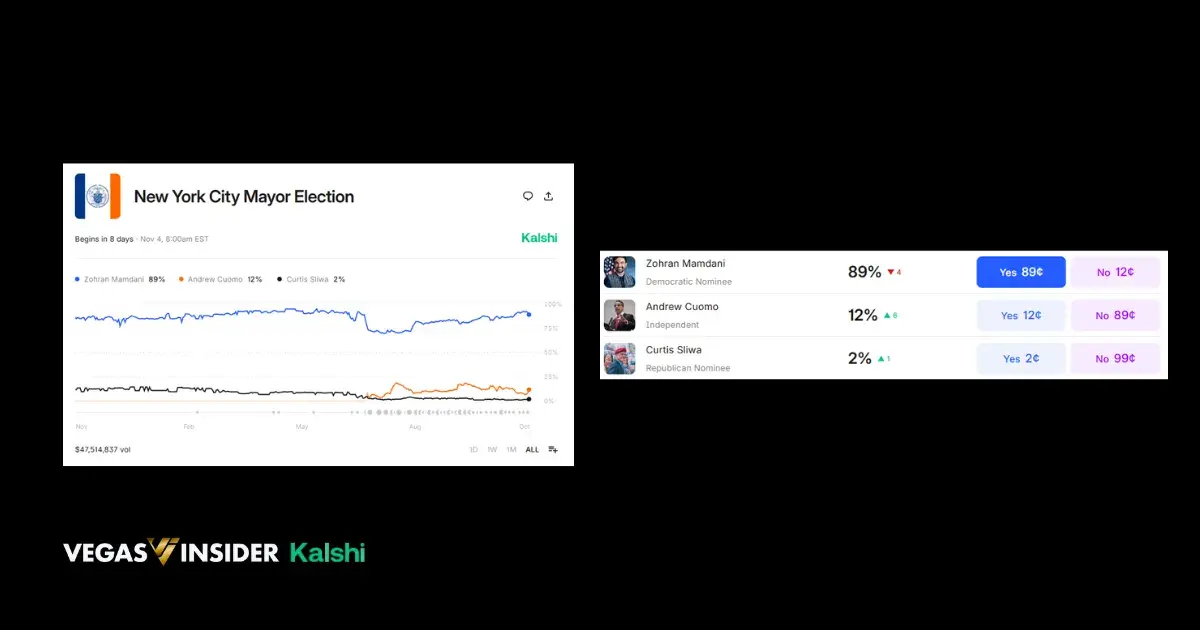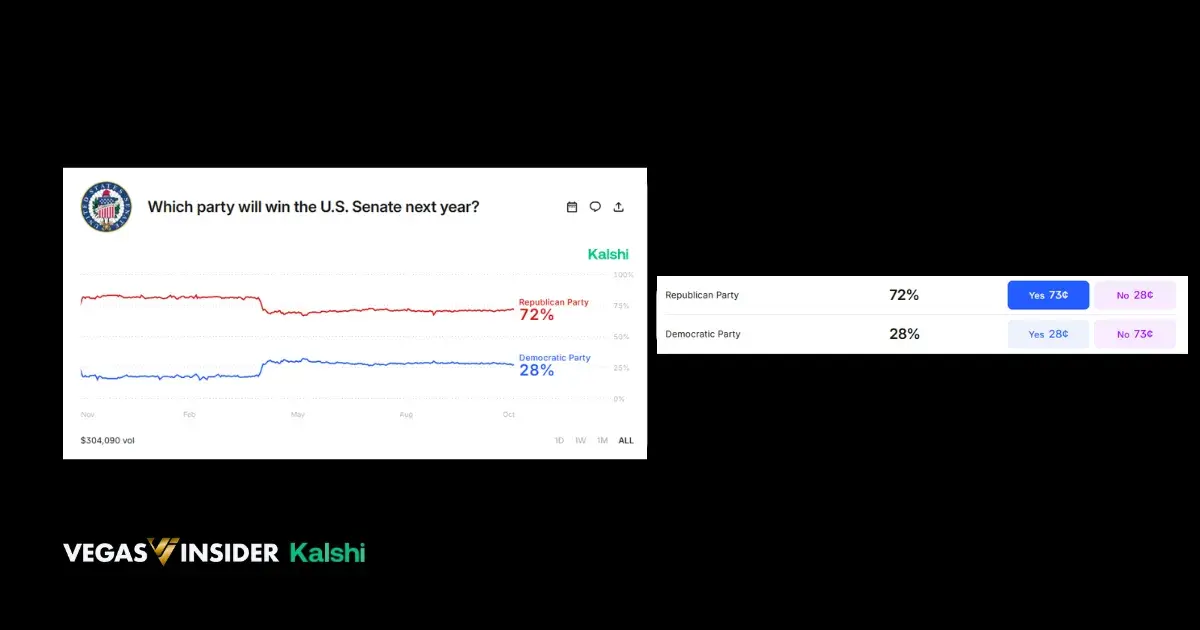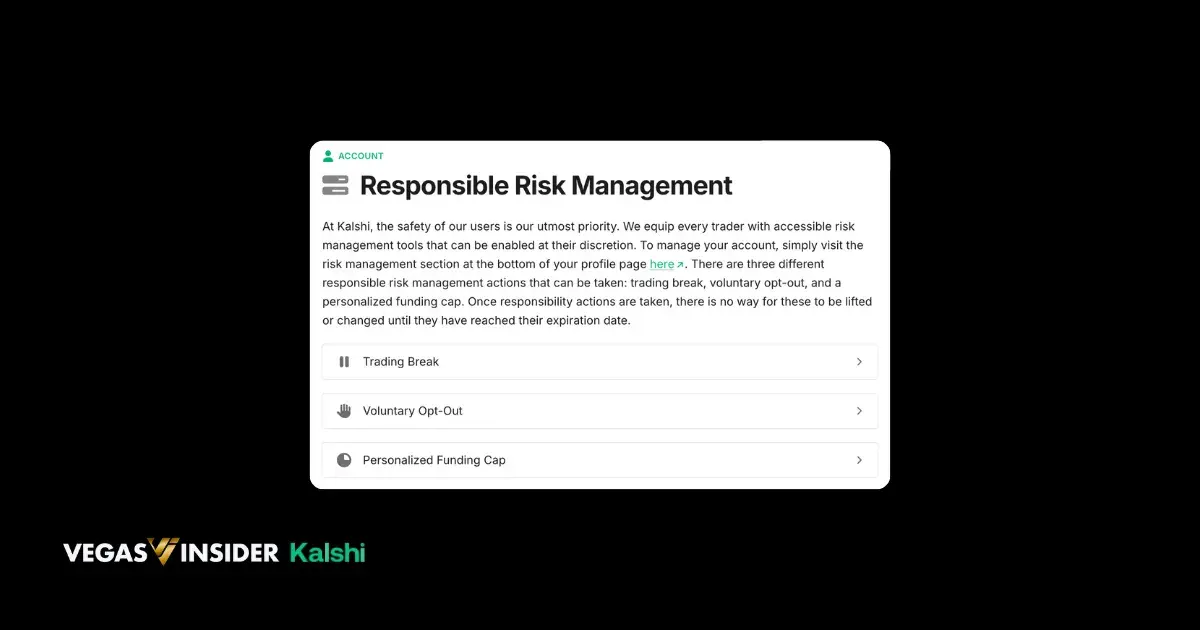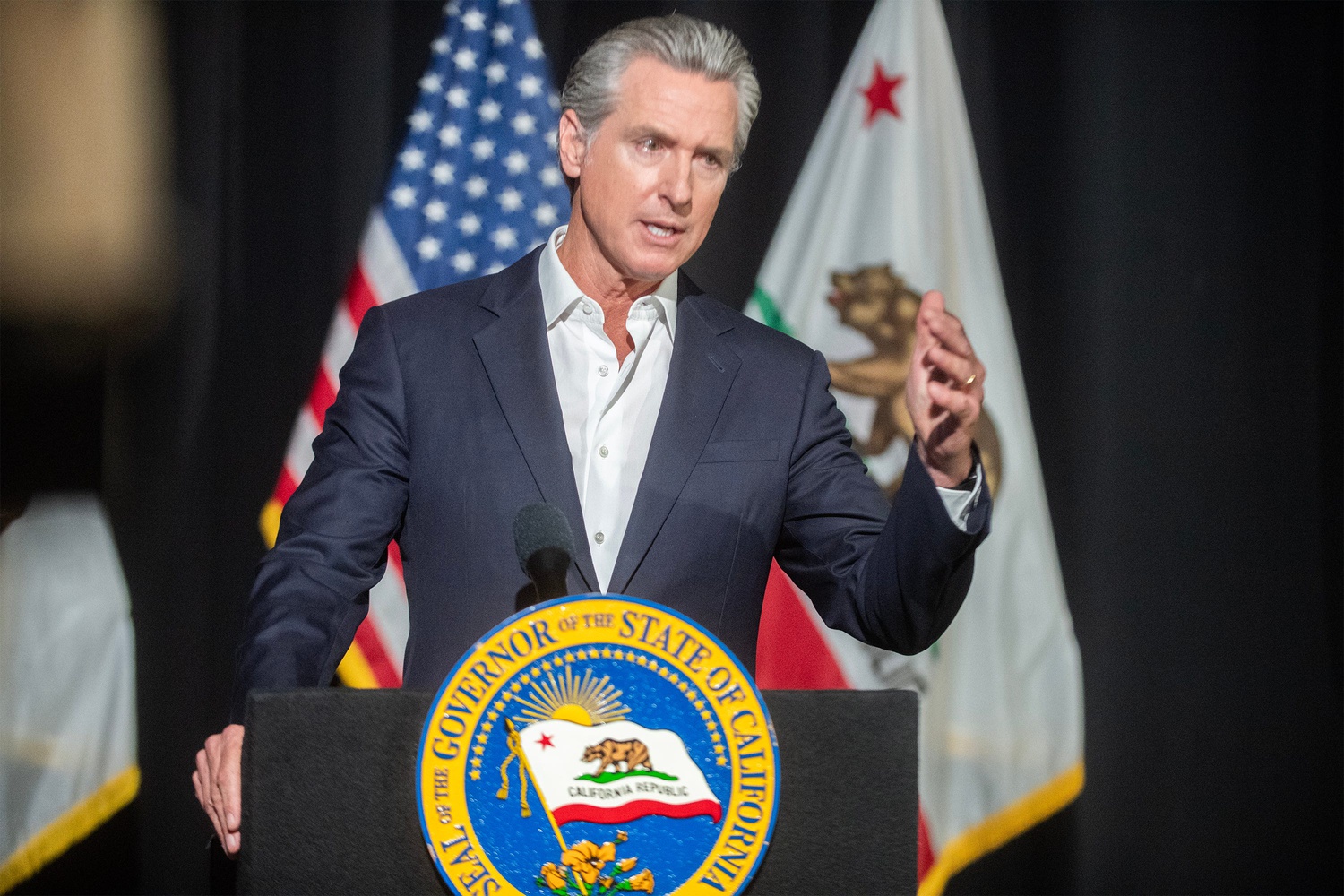What Are Kalshi Election Markets?
| Online Sportsbooks · Kalshi · Election Markets |
Kalshi election markets are regulated prediction markets where you trade yes-or-no event contracts on election outcomes. Prices range from 1 to 99 cents and settle at $1 if the outcome occurs, so the price reads like a probability. The exchange operates under the Commodity Futures Trading Commission (CFTC) with order books and market makers you’d expect in financial markets, not sports betting.
Start with a small test trade, then check today’s most active races to see how headlines move contracts in real time on Kalshi.
Use our Kalshi promo code INSIDER to
You will receive your $10 bonus after your first $100 in trades.
TL;DR
- Trade event contracts on political outcomes, from federal elections to which political party controls Congress.
- A 62-cent contract implies roughly 62% and pays $1 for a "yes" and $0 for a "no".
- CFTC-regulated exchange structure with transparent order books and liquidity from market makers.
- Good for hedging against election results or tracking sentiment that updates faster than polls.
- Keep sizing modest, confirm fees and settlement sources, and check liquidity before placing or lifting an order.
Booming Popularity of Election Prediction Markets
Kalshi election markets have shifted into high gear this fall. New York City’s 2025 mayoral race is moving daily on endorsements and debate talks, and sub-markets like“second place in NYC Mayor” are logging heavy 24-hour flow. If you want real-time reads instead of waiting for the next poll, this is where traders are spending time.
Kalshi’s Most Popular Election Markets

What’s drawing the most eyes right now? Big-city races with nonstop coverage, party-control boards that frame the balance of power, and the 2028 presidency. Below are the active anchors to watch and why they trade.
2025 New York City Mayoral Race
- Why it’s popular: NYC pulls national attention fast. The board moves on every debate clip and endorsement, and the finish-position event contracts trade with real liquidity thanks to active market makers. It’s the quintessential use case for prediction markets inside Kalshi election markets.
- What to watch: Debate nights, late polling, and any ground-game stories that hint at turnout. If a political party machine flexes, you’ll see it in the price before you see it in headlines.
- Live data (Oct 28, 2025): “Second place in NYC Mayoral election?” shows Andrew Cuomo 88%, Zohran Mamdani 11%, Curtis Sliwa 4%, with about $2,303,931 in lifetime volume.
2028 US Presidential Election
- Why it’s popular: Clean yes-or-no framing on who wins the White House. It’s where many start, then branch into nominee boards and state angles. Great if you want a light hedge against national election outcomes that can spill into markets outside politics.
- What to watch: Fundraising reports, debate moments, and heavyweight surrogates that actually move undecideds. Prices here tend to adjust faster than polls, which is why traders keep it pinned on their screens.
- Live data (Oct 28, 2025): Party contract (“Which party will win the 2028 Presidential Election?") reads Democratic 53% and Republican 47% on the headline market.
2026 California Gubernatorial Election
- Why it’s popular: Biggest state, constant media, and a deep bench of potential entrants. As the field sets, the contract suite becomes a clean way to express views on political outcomes without wading through fifty local rules.
- What to watch: Who actually files, who bows out, and where the money flows. A splashy announcement can fade in a day; real changes show up when rumored coalitions harden and donor lists grow.
- Live data: Prices and 24-hour volume update intraday on Kalshi’s California governor market; figures change throughout the day.
2026 House of Representatives Elections
- Why it’s popular: Straight question, big stakes. Which political party will control Congress in the House after the midterms. If you like portfolio-level views on federal elections, this is the anchor.
- What to watch: Filing deadlines, primary results, and any court decisions that reshape maps. Liquidity usually improves as districts lock and more contracts list, which tightens spreads and sharpens signals.
- Live data (Oct 28, 2025): The House control header had Democrats ahead on price.
2026 Senate Control

- Why it matters: Fewer seats, bigger swings. One retirement or a fundraising shock can switch the tape. Pairs well with House control if you’re going for a broader congressional elections view.
- What to watch: State-level nominee boards that ladder into overall control. Debate calendars and late-breaking special elections are classic catalysts.
- Live data: A mid-July Kalshi news post pegged Republicans near 70% at the time; current pricing updates intraday.
Live Data note
Prices update intraday on Kalshi; some total-dollar volumes are visible only when logged in. Figures above are time-stamped Oct 28, 2025.
Kalshi and CNN Partnership
CNN has partnered market leader Kalshi to enhance its news coverage with real-time probability data.
Through this deal, CNN's Harry Enten will tap into Kalshi's data for his analysis, a new live ticker will display prediction market information during broadcasts, and CNN's newsroom will have full access to Kalshi's platform for story development.
Other Popular Kalshi Political Markets
Kalshi isn’t only about mayors, the presidency, or who will control Congress. The board also fills with smaller but lively prediction markets tied to the news cycle and political culture. Think turnout thresholds, debate-performance lines, ballot-access questions, leadership votes, and policy clocks that hinge on state law or agency deadlines.
You’ll also see occasional list contracts that let you price a set of names rather than a single race, plus narrowly framed event contracts on procedural steps that feed into larger election outcomes. During public comment, some officials and outside investors argued for and against approval, citing concerns about how the exchange would offer contracts while still protecting election integrity nationwide.
But how did we get here? After an appeals court allowed regulated election trading in late 2024, the Commodity Futures Trading Commission continued to supervise how the exchange lists and polices markets in the public interest. You’ll sometimes see references to Kalshi’s proposal on congressional control and language like “CFTC contends” or “Kalshi contends” in the docket history; it’s the normal push-and-pull over what contracts the market should offer and how to preserve election integrity. The end result for traders is a curated menu that changes over time as rules evolve.
Two notes for Kalshi users: first, these are part of financial markets, not sports betting, even if the cadence can feel like tracking the Kentucky Derby or a playoff series. Second, smaller markets can have thinner liquidity, so prices may move faster on headlines. If you follow committee calendars, filings, or “will-they-won’t-they” candidacies, you’ll find a ton of future-facing angles to trade without waiting for the next poll.
Think of it this way: companies treat these signals like risk inputs, while bettors watch the headline races; same tempo, different playbooks.
Trading Responsibly on Kalshi & Customer Service Options

Treat election trading like any other portfolio sleeve. Size modestly, set dollar limits per idea, and remember that even well-informed traders can be early or wrong on an outcome. Kalshi is a CFTC-regulated venue, which means surveillance for market manipulation, rulebooks for contracts, and settlement procedures designed to keep event contracts tied to verifiable election results. If you are using markets tied to federal elections or congressional elections, read each contract’s rules before you place an order.
The responsible gambling-like tools you can use on-platform include basic trading break, voluntary opt-out, personalized funding cap, and account security features that help you operate with discipline. For questions, head to the Help Center or reach support by email; responses go straight to the point and focus on the contract’s rules, fees, and mechanics. If your question touches regulation, staff will point you to the appropriate materials from the Commodity Futures Trading Commission and Kalshi’s own documentation.
None of this is a license to overextend. Keep cash aside, assume variance, and avoid treating the politics industry like gaming.
Final Tips for Trading on Kalshi’s Election Markets
Kalshi lists election-focused events contracts that price political risk in real time. Prices reflect the market’s best read of probability and will move when fundraising, debates, or filings change the map. You’re trading on an exchange, not “betting”,with rules that flow from the regulator and the venue’s own listing standards.
Smart habits
- Start with the liquid boards first. Party control for the House or the presidency tends to carry the deepest books and cleaner fills.
- Think in scenarios. If you hold presidency, check how that view pairs with Senate or House to hedge a portfolio tied to policy risk or to win on relative moves even if headline calls are choppy.
- Read the contract rules every time. Settlement sources, timing, and edge cases matter for contracts tied to close elections.
- Respect fees and execution. Place limits, watch the spread, and avoid chasing when liquidity thins after hours.
- Keep the legal context in view. The regulator’s job is to serve the public interest; listings can evolve after a court ruling or new guidance. If something changes, the board will reflect it.
- Separate signal from noise. A viral clip might fade; filings, ballot access, cash-on-hand, and confirmed data matter more. For instance, headlines about a national figure like Donald Trump Jr can move sentiment, but you should still wait for verification before you trade.
In short, treat Kalshi election markets like any other part of the market stack, keep risk in check, and let real information, not rumors, drive your trading decisions.
Want a break from politics? Check out the exchange's pop-culture boards and read our Taylor Swift prediction markets on Kalshi review.
Kalshi Election Markets FAQs
Does Kalshi have election prediction markets?
Yes. Kalshi lists regulated prediction markets as yes-or-no event contracts on election outcomes, overseen by the Commodity Futures Trading Commission. An appeals court ruling in 2024 allowed regulated election trading to proceed in the public interest, with an eye on election integrity.
What elections can I predict on Kalshi?
You can trade contracts tied to federal elections, marquee races, and which political party will control Congress in the House or Senate. Kalshi also posts narrower boards, including list contracts, when those help price the larger outcome.
Is the presidential election on Kalshi?
Yes. Party-to-win and related nominee contracts are available as regulated event contracts on the exchange. Prices move like other financial markets when news lands and traders reposition.
How do I earn interest on Kalshi election markets?
Eligible idle cash can earn variable interest that’s posted in your account; rates can change. Interest is separate from price moves on your contracts and has nothing to do with wagers or gaming.
Do I pay fees or taxes on Kalshi election markets?
Yep. You pay trading fees per the posted schedule; tax treatment depends on your situation and state law, especially for futures contracts or similar derivatives contracts. For clarity, review Kalshi materials and the regulator’s guidance from the Commodity Futures Trading Commission (CFTC).
Politics News
-
 POLITICS DEC 8, 2025
POLITICS DEC 8, 20252028 Democratic Nominee For President Odds: Gavin Newsom In Front
-
 POLITICS OCT 31, 2025
POLITICS OCT 31, 2025GOVERNMENT SHUTDOWN ODDS: HOW DO THEY WORK?
-
 POLITICS DEC 10, 2025
POLITICS DEC 10, 2025What Are Kalshi Election Markets?
-
 POLITICS NOV 20, 2025
POLITICS NOV 20, 2025What Are Kalshi Election Markets?
-
 POLITICS DEC 5, 2024
POLITICS DEC 5, 20242028 Presidential Election Odds: VP Vance Very Early Front-Runner
-
 POLITICS NOV 6, 2024
POLITICS NOV 6, 20242024 Presidential Election Odds: Harris vs. Trump Down to the Wire







